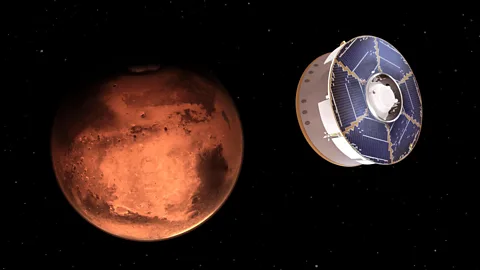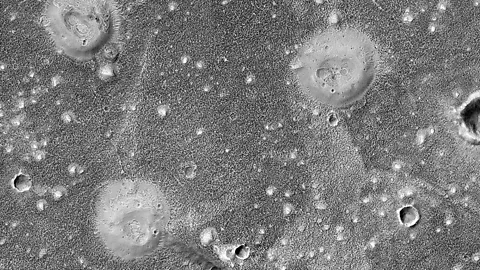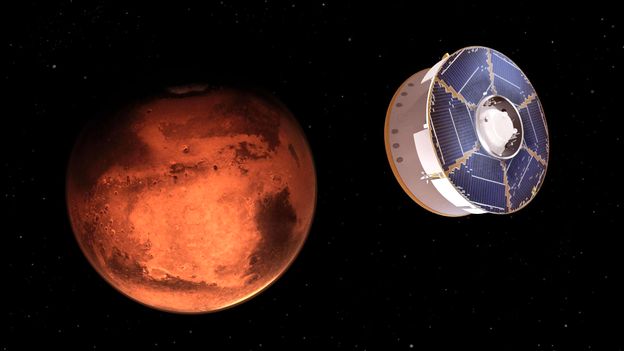 NASA/JPL-Caltech
NASA/JPL-CaltechTo understand what life might survive deep within the surface of Mars, we need to look to some of the deepest and oldest forms of life on our planet.
Mars isn’t just a red planet: it’s also a wet planet. On August 12, US researchers reported evidence of A huge tank of liquid waterdeep within the planet’s rocky crust.
The data came from NASA’s Mars Insight lander, which recorded more than 1,300 Martian quakes over four years. Researchers led by Vashan Wright, a geophysicist at the Scripps Institution of Oceanography at the University of California, San Diego, studied the seismic waves that reached the lander and concluded that They passed through layers of wet rock.Although the surface of Mars is a barren desert, Wright’s data indicate that there are large amounts of water trapped in rocks between 11.5 and 20 kilometers (7.1 and 12.4 miles) below the planet’s surface.
“If these predictions are correct, I think this is a game changer,” says Karen Lloyd, a subsurface microbiologist at the University of Southern California in Los Angeles.
The presence of groundwater on Mars opens the door to the possibility of underground life on Mars. The past few decades have revealed a vast biosphere hidden deep underground. Now it seems the same may be true on Mars. If life on Mars does exist, it could be underground.
deep biosphere
For more than 30 years, biologists have gathered evidence that Life goes on deep underground. On Earth, researchers have drilled deep into the seafloor and continents, finding life in buried sediments and even among layers and crystals of solid rock.
Most of these creatures that live in the dark are single-celled microorganisms, especially bacteria and archaea. These two giant groups are the oldest known life forms on Earth: they have existed for more than three billion years, long before animals and plants appeared.
Over the past twenty years, it has also emerged that deep biosphere “It’s actually very diverse. There are actually many different types of organisms living deep underground,” says Cara Magnabosco, a geologist at the Swiss Federal Institute of Technology in Zurich.
Bacteria are divided into large groups called phyla: only a few dozen of these groups have been formally recognized, among them: Estimated 1300“Almost all of these phyla can be found underground,” says Magnabosco.
 NASA
NASABecause they are so black, these microbes can’t get energy directly from sunlight, as photosynthetic organisms on the surface do. “The really important thing to note is that these microbes are not, to a large extent, dependent on the sun,” Lloyd says.
They also don’t receive any other inputs, such as nutrients, from above. Many of these deep ecosystems are “completely disconnected from the surface,” says Magnabosco.
Instead, these ecosystems rely on chemosynthesis. Microbes get their energy by performing chemical reactions, taking in chemicals from surrounding rocks and water. For example, microbes might use gases like methane or hydrogen sulfide as a source of materials. “There are a lot of different chemical reactions going on in the Earth’s interior,” Lloyd says. “And a lot of us spend a lot of time looking for new reactions that support life.”
While single-celled microbes dominate the Earth’s interior, there are some rare animals. A 2011 study identified Nematodes in broken water 0.9 to 3.6 kilometres (0.6 to 2.2 miles) below the South African mines. The water appears to have been there for at least 3,000 years, suggesting the nematode population may be thousands of years old. A follow-up study in 2015 found Flatworms, segmented worms, rotifers, and arthropods In the crack waters at a depth of 1.4 kilometres (0.9 mi): The water there was up to 12,300 years old. The animals were feeding on a thin layer of microbes on the surface of the rock.
 NASA/JPL/Caltech/University of Arizona
NASA/JPL/Caltech/University of ArizonaIf you go deep enough underground, pressure also becomes an issue. The type of rock is also important, because It affects the chemical reactions that can occur. So the types of chemosynthetic microbes that could live there. “But I can’t give you a number. [on how far down life exists] “Because we haven’t reached it yet, because we haven’t drilled very deep,” Lloyd says. The limit may be surprisingly deep: A 2017 study of samples from a mud volcano suggested that it could be surprisingly deep. Life may exist 10 kilometers (6.2 miles) below the seafloor.
Some of these life forms are extremely slow. “There are certainly large parts of the Earth’s interior, especially beneath our oceans, where nothing really happens for millions of years,” Lloyd says. With no new nutrients coming in from above, and no way to escape, microbes in these places get very little to eat. “That means they simply don’t have the energy to make new cells,” she says. Instead, they slow down their metabolism and are almost in a state of stasis. “It’s entirely plausible that a single cell could survive for thousands of years or more.”
This type of life—which relies on chemical reactions between rocks and water, and perhaps with a very slow metabolic rate—is likely to exist in water-rich rocks deep beneath the Martian surface.
Martian microbes
There is still no concrete or direct evidence of life on Mars, despite decades of unmanned missions to the Red Planet. The surface is dry and cold, and no living organism has ever stepped into the frame of a Mars rover’s camera.
However, features like the canyons strongly suggest that Mars had running water on its surface billions of years ago. Some of that water may have been lost to space, but Wright’s team concluded that much of it is underground.
“We know that water is a prerequisite for life as we know it,” Lloyd says. So perhaps the surface of Mars was once habitable, and now only the lower part is habitable. “I’ve always liked the idea that life would be buried in some way,” she says.
Like the slow microbes that live deep in Earth’s oceans, Martian microbes may be clinging to life Despite the scarcity of nutrients, Magnabosco says, “the same kind of processes that happen in the Earth’s interior could happen on Mars.”
The most suggestive evidence of life so far is Plumes of methane gas in the Martian airany Varies with seasonsOn Earth, methane is often produced by microorganisms—so the gas could be a waste product of underground life. However, Lloyd urges caution. “There are many non-living reasons why methane plumes could be created,” she says.
Moreover, there are many other obstacles that prevent Life in the interior of Mars“Life doesn’t just need water,” Lloyd says. “It needs energy and space, so it needs habitat.” We don’t yet know if the pores in Martian rocks are big enough for microbes. Similarly, Chemical composition of deep rocks This is very important, as it will be a source of chemical energy.
For Magnabosco, the “biggest uncertainty” about life on Mars “is whether it ever arose.” Because we don’t know how the first living things formed from nonliving materials, we don’t know whether conditions on Mars ever arose at all. Suitable for the emergence of life“If life was able to evolve on Mars,” she says, “it has a very good chance of surviving and being on Mars today.”
If this deep biosphere exists on Mars, how would we find it? The obvious idea is to drill into Mars, but we would need to drill 10 kilometers (6.2 miles) or more deep—a tall order even on Earth. Doing that on a planet that lacks breathable air or running water? “It’s much harder,” says Magnabosco.
“Chasing methane would be really useful,” Lloyd says. “Right now, we don’t know where the gas is coming from. If we find pockets of water associated with methane plumes,” This would be a suggestion. Of life, you say.
Finally, if Mars does indeed have water moving around, we could take advantage of that. On Earth, features like hot springs bring water From the depths of the earth to the surface“There are mud volcanoes on Mars,” Lloyd says. “There are places on Mars where you can go where you can find samples deep beneath the surface that have been extracted and brought to the surface.”
It could be decades before we have a definitive answer. And that answer could be frustrating: Mars is less tectonically and hydrologically active than Earth, suggesting that life is either rare or nonexistent. “We might be looking for life that hasn’t been around for a long time,” Lloyd says. In that case, we might find only fossil evidence, not living organisms. “Either way, it’s life on Mars,” she says.
If you like this story, Subscribe to the newsletter for the main list – A hand-picked selection of can’t-miss features, videos and news, delivered to your inbox twice a week.
For more science, technology, environment and health stories from the BBC, follow us on Facebook and X.

“Typical beer advocate. Future teen idol. Unapologetic tv practitioner. Music trailblazer.”








More Stories
Boeing May Not Be Able to Operate Starliner Before Space Station Is Destroyed
How did black holes get so big and so fast? The answer lies in the darkness
UNC student to become youngest woman to cross space on Blue Origin